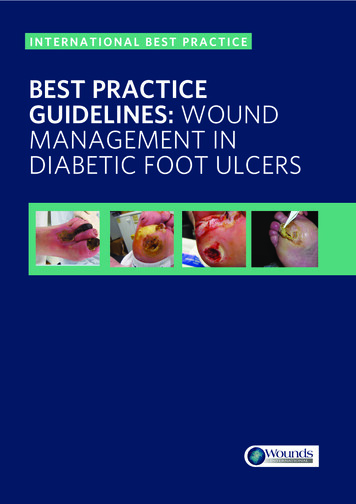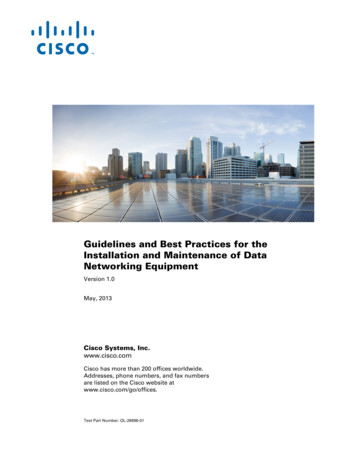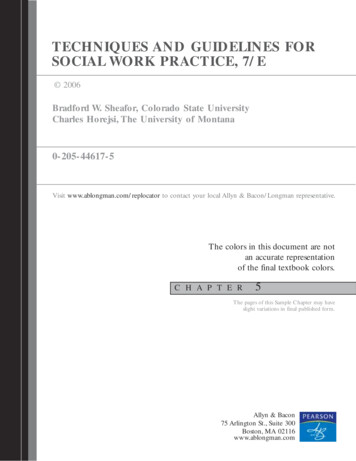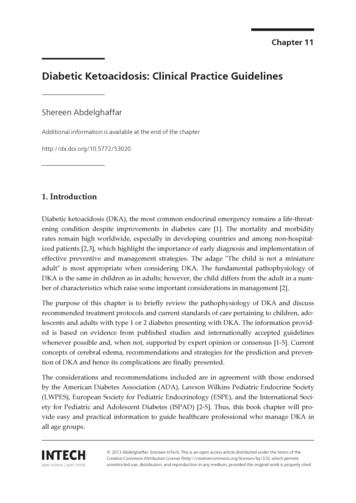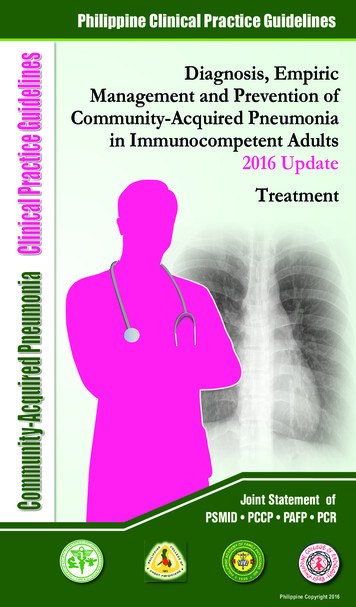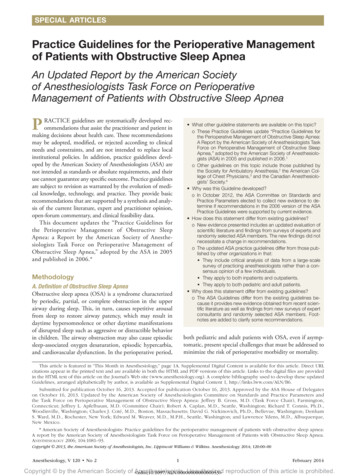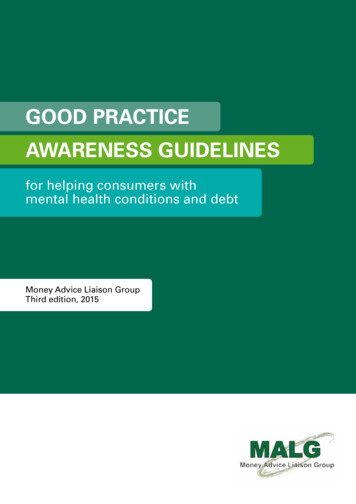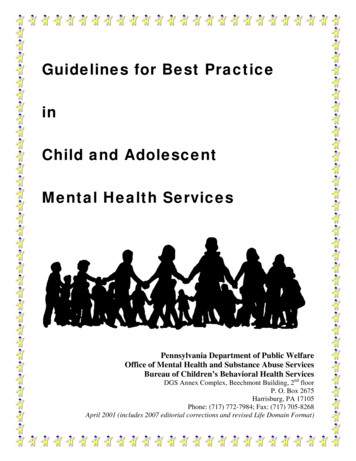
Transcription
Guidelines for Best PracticeinChild and AdolescentMental Health ServicesPennsylvania Department of Public WelfareOffice of Mental Health and Substance Abuse ServicesBureau of Children’s Behavioral Health ServicesDGS Annex Complex, Beechmont Building, 2nd floorP. O. Box 2675Harrisburg, PA 17105Phone: (717) 772-7984; Fax: (717) 705-8268April 2001 (includes 2007 editorial corrections and revised Life Domain Format)
Guidelines for Best Practice in Child and Adolescent Mental Health ServicesPage 2 2001TABLE OF CONTENTSORIENTATION TO THE GUIDELINES AND TO THE SYSTEM OF CAREIntroductionCharacteristics of a Positive Public Sector Culture47ASSESSMENTPsychiatric/Psychological Evaluations Parameters of Strengths-Based Systemic Assessment in Child and Adolescent Mental Health Psychiatric/Psychological Evaluation: Discussion of Goals and Format Life Domain Format for Psychiatric/Psychological Evaluation: Initial and Continued Care(Revised 2007) Twelve Treatment Issues to Consider Prior to Thinking About Specific Services Formulating the Prescription/Service Selection: Guiding Questions for the Evaluator Characteristics of a Quality Evaluation Report Selected Ethical Issues for Any Evaluator and for the BHRSCA Prescriber17182021Strengths-Based Assessment Report Protocol for a Strengths-Based Assessment Report The Necessity of Strengths-Based Treatment Planning Within Managed Care2325Other Assessment Guidelines Questions to Guide Human Service Responses to Children or Adolescents with Serious MentalHealth Problems Documenting the Need for Mental Health Services in the Schools Child and Adolescent Readiness for Nonviolent Problem Solving: Assessment Parameters Parameters for Reassessment for Stalemated or Unsuccessful TreatmentPRACTICEOverview Expectations for All Individualized, Community-Based, Enhanced Mental Health Services Expected Practices with “Wraparound Services” Thirteen “Lessons” About Behavioral Health Rehabilitation Services for Children andAdolescents (BHRSCA), Based on Fee-for-Service and Managed CareStrengths-Based Treatment Strengths-Based Treatment: What It Is and What It Isn’t The Role of Natural Supports in Behavioral Health Treatment for Children and Adolescents “Presuming the Positive” as Part of Strengths-Based Treatment in Working With Children andFamilies8910122631333640414345465053The Clinical Interview Building Blocks of the Clinical Interview The Satisfaction Question5960Collaboration with Parents and Children In Support of Genuine Parent-Professional Collaboration Rights and Responsibilities in Psychotherapy Working with Children and Adolescents Who Are Defiant: Unconditional Respect Comes First616366
Guidelines for Best Practice in Child and Adolescent Mental Health ServicesPage 3 2001Tips for the Psychiatrist Working with the Treatment Team71Cultural Competence Engaging Minority Children and Adolescents Through Respect Potential Pitfalls in Working with Minority Populations7374Interagency Team Meetings An Effective Interagency Team Meeting Making Interagency Team Meetings Effective The Real Impartial Review: The Interagency Team Meeting757692Home-Based Treatment Principles of Effective Home-Based Treatment Key Concepts for Home-Based Clinicians and Workers FBMHS (“Family-Based”) vs. BHRSCA (“Wraparound”) Selected Ethical Issues for Behavioral Health Therapists and Workers95969798Specific Use of Therapeutic Staff Support (TSS) Implementation of Therapeutic Staff Support: Practical Approaches TSS in Action: The TSS Worker Promoting a Specific Community Integration Activity(Basketball) Therapeutic Staff Support: A Mental Health Service, Not a Big Brother/Big Sister Therapeutic Staff Support in the School: Addressing Special ChallengesPsychotropic Medication Promoting Appropriate Use of Psychotropic Medication for Children and Adolescents Common Myths and Misconceptions about Psychotropic Medication for Children andAdolescents Possible Clinical Indications for Psychotropic Medication for Children and Adolescents Initial Psychotropic Medication Discussion with the Child and Family Following thePsychological Evaluation Psychotropic Medication: Addressing Child and Adolescent Concerns (with the Child Alone, orthe Child with the Family)Self-Assessment for Prescribers and Clinician Biopsychosocial Treatment: ORAL HEALTH SUBMISSIONSApplicable to Any Service System Key Areas to Address in EPSDT Mental Health Submissions117118Adaptation to Behavioral Health Managed Care Obtaining Service Approvals: Suggested Approaches Within Managed Care120ADDITIONAL DOCUMENT Core Principles, Child and Adolescent Service System Program (CASSP)123124
Guidelines for Best Practice in Child and Adolescent Mental Health ServicesPage 4 2001INTRODUCTIONThe documents in Guidelines for Best Practice in Child and Adolescent Mental Health Servicesaddress many of the clinical challenges that practitioners regularly face, by offering a set of qualitativestandards. Developed over time based on cumulative experiences within the children’s system of care andconsistent with CASSP Principles, the documents address a range of tasks, issues, and topics and areintended to help agencies and practitioners achieve a high quality of care. The overriding assumption isthat effective clinical practice facilitates positive outcomes. Protocols and discussion papers can create auseful framework for systematic, conscientious clinical pursuit. Ultimately, however, specific decisionswithin a service system that values individualization are made on an individualized, clinical basis.There are three main sections: Assessment, Practice, and Behavioral Health Submissions. Withineach of these sections, documents are organized according to specific topics. In what follows, eachsection will be discussed further.Assessment:The Assessment section first addresses psychiatric and psychological evaluations. Although thedisciplines of psychiatry and psychology differ in training and expertise in some ways, in Pennsylvaniaboth psychiatrists and psychologists can serve as “prescribers” of community-based behavioral healthservices. Both can also prescribe non-JCAHO residential treatment facilities (RTFs), but onlypsychiatrists prescribe for JCAHO RTFs. The evaluation protocol presented applies to both disciplines foruse when behavioral health services are being requested. The protocol can be used, as described here,with slight modification, for both initial and continued care requests. It can also be used to request alllevels of care, not just Behavioral Health Rehabilitation Services (BHRS) and RTF services. Since theLife Domain Format helps the evaluator obtain comprehensive information about the child that includesbut goes beyond presenting behaviors and symptoms of concern, it can be used whether or not BHRS andRTF are being requested (note the 2007 revision of the Life Domain Format).A useful evaluation cannot be part of an assembly-line process, and instead must be theconsidered summation of an evaluator’s intense contact with a unique child and family at a criticalmoment in time. A useful evaluation should build on child and family experiences and include thoughtful,individualized recommendation. Therefore, it is appropriate that the key aspects of the evaluation process(interview, written report, and recommendations) are also considered here from an ethical perspective.The Assessment section also discusses a Strengths-Based Assessment Report. The inclusion ofguidelines for a Strengths-Based Assessment Report must not mislead practitioners into believing that theidentification of the child and family strengths can be assigned to only one specific individual. Identifyingand building upon strengths is the responsibility of every professional and support person who encountersthe child and family. Strengths best emerge by listening to the child and family, asking questions, andengaging in unpressured discussion. The Strengths-Based Assessment Report is an additional procedurethat can be used to elucidate strengths and competencies, but in no way relieves each of us from doing thesame.Finally, the Assessment section considers two important special topics. Given the importance ofcomprehensive information when school-based services are used, this issue is addressed (“Documentingthe Need for Mental Health Services in the Schools”). Given the public health concern about youth
Guidelines for Best Practice in Child and Adolescent Mental Health ServicesPage 5 2001violence, as assessment tool related to this topic is included (“Child and Adolescent Readiness forNonviolent Problem-Solving: Assessment Parameters”).Practice:“Practice” here refers to all processes other than evaluations and assessments that involvequalitative aspects of treatment interventions with the child and family, collaboration, treatmentmonitoring, and the use of natural supports. Case-specific efforts at sound practice, as important as theyare, cannot sustain our important behavioral health initiative unless accompanied by efforts at all levels tocreate a positive public sector culture. Each of us is obliged to make this effort, and to enlist the supportof others in this endeavor.It needs to be recognized that most procedures within these documents for sound practice withBHRS apply also to other services, including traditional outpatient treatment. The focus on so-called“wraparound services” emerged in recent years because these were the newest and potentially mostflexible services. However, the guidelines in this packet apply to other services and levels of care. Itshould also be appreciated that the availability of BHRSCA in no way renders traditional outpatienttreatment obsolete. Outpatient therapy remains the least intrusive, most normalized, behavioral healthservice, and should be used when clinically best suited to the child’s needs.The Practice section also delineates some aspects of strengths-based treatment and discusses theuse of natural supports. Other topics include: the clinical interview; methods for achieving collaboration;specific aspects of cultural competence; the interagency team meeting; guidelines for home-basedtreatment (e.g., BHRSCA and Family-Based Mental Health Services); use of Therapeutic Staff Support(TSS), when medically necessary; use of psychotropic medication; and a self-assessment document topromote the implementation of genuine biopsychosocial treatment.Behavioral Health Submissions:Since a funding source typically does not observe actual evaluation and clinical practice, there isreliance on documentation to determine medical necessity for initial care and continued care requests,respectively. We presume that the provider who comprehensively documents need and treatment isoffering comprehensive treatment as well. While this is not always the case, the frequent associationbetween documentation and practice should not come as any surprise. For example, comprehensiveevaluations, progress notes linked to an individualized treatment plan, and evidence of frequentcommunication and collaboration, including team meetings convened as clinically indicated, all representsound work efforts likely to result in positive outcomes and satisfied clients.The Behavioral Health Submission section includes guidelines for behavioral health submissionsto any funding source, and to behavioral health managed care under HealthChoices in Pennsylvania. Hereagain, although the identified focus may be on “wraparound services,” the suggestions are clinically basedand apply to a full range of service requests.The packet closes with an original “Rap for Pennsylvania CASSP Principles” and Pennsylvania’sformal description of CASSP Principles. Given the centrality of CASSP principles to our children’ssystem, it is important that these principles be understood by as many stakeholders as possible. This rap,playful yet serious, is intended to offer another vehicle to reinforce these principles, and to promote apositive public sector culture.
Guidelines for Best Practice in Child and Adolescent Mental Health ServicesPage 6 2001Conclusion:The Guidelines for Best Practice in Child and Adolescent Mental Health Services is a collectionof documents that broadly addresses, through qualitative standards, many of the challenges facingagencies and practitioners in daily work. The scope includes Assessment, Practice, and Behavioral HealthSubmissions. Although often pitched to BHRS, the guidelines in fact are more generic and apply to therange of services for children and adolescents and their families.Given the breadth of behavioral health assessment and service provision, these guidelines are notfully inclusive. Choices had to be made. The documents, however, are the end product of a series ofissues identified statewide as being important to clinicians, children and families. I hope they will helpyou in your efforts to support children and families.Gordon R. Hodas, M.D.Statewide Child Psychiatric ConsultantOffice of Mental Health and Substance Abuse ServicesApril 2001
Guidelines for Best Practice in Child and Adolescent Mental Health ServicesPage 7 2001CHARACTERISTICS OFA POSITIVE PUBLIC SECTOR CULTURE1.Clear values for system of care.2.Clear practice expectations.3.Facilitative regulations.4.Empowered families and advocates, with participation in policy development.5.Preparation and dissemination of guidelines for best practice.6.Emphasis on training and technical assistance.7.Use of newsletters to communicate new ideas, share experiences, and celebrate success.8.Presence in every county.9.Decentralized structures for decision-making.10.Cross-systems initiatives.11.Using managed care and welfare as tools for positive systems change.12.Careers and prestige for public sector clinicians and workers.
Guidelines for Best Practice in Child and Adolescent Mental Health ServicesPage 8ASSESSMENT 2001
Guidelines for Best Practice in Child and Adolescent Mental Health ServicesPage 9 2001PARAMETERS OF STRENGTHS-BASEDSYSTEMIC ASSESSMENTIN CHILD AND ADOLESCENT MENTAL HEALTHA.B.C.Strengths Within System1.Strengths of individual child or adolescent2.Family strengths: individuals, relationships, resources, goals/aspirations3.Cultural strengths: expectations, rituals, other practices4.Interagency strengths: resources and relationships5.Community strengths: resources and relationshipsPossible Needs/Concerns1.Economic factors/concrete service needs2.Racism or other types of discrimination3.Individual vulnerabilities: child/adolescent, other family member4.Family vulnerability: fragile relationships5.Cultural variation6.Interagency vulnerability: limitations of resources, agency conflict, family-agencyconflictDesired Outcomes1.Active child and family participation during assessment and treatment—treatmentplanning, implementation, monitoring. Family as full partner in treatment team.2.Development of respectful, trusting relationships among providers, child and family.3.Development of consensus within interagency treatment team re: strengths/needs, goals,treatment plan, specific services.4.Services fully consistent with CASSP principles.
Guidelines for Best Practice in Child and Adolescent Mental Health ServicesPage 10 2001PSYCHIATRIC/PSYCHOLOGICAL EVALUATION FORWRAPAROUND OR RESIDENTIAL TREATMENTDiscussion of Goals and FormatThe goals of the Life Domain Format for Psychiatric/Psychological Evaluations: Initial andContinued Care are:a.To help the evaluator implement a strengths-based interview and written report thatidentify competencies and resources as well as needs, so that each child and adolescentcan be understood biologically, psychologically, and socially (e.g., understood withinvarious life domains), resulting in a comprehensive understanding of the child andfamily.b.To help the evaluator identify crisis situations, and ascertain when a child requires ahighly restrictive level of care such as inpatient psychiatric hospitalization or RTF.c.To help the evaluator to obtain core information, so that the interagency team is free topromote an envisioning of positive, future outcomes and to develop a creative treatmentplan, rather than engage in a recitation of past failures.d.To assist the evaluator in recommending individualized services and natural supportsconsistent with CASSP Principles, which support the child’s remaining in the naturalfamily or elsewhere in the community, when possible, or the child’s successful return tothe community.e.To support the inclusion of parents/caregivers and other treatment team members in aportion of the evaluation process.f.To encourage participation by the psychiatrist or psychologist as an active member of theinteragency and treatment teams, helping to achieve consensus regarding needs andservices, and monitoring progress.g.To create a comprehensive document that serves as a baseline for future evaluations, andas a source of reference for a subsequent review of the child’s progress over time.This recommended format guides the systematic collection of core information about a child oradolescent with a serious emotional disorder, and assists the evaluator in prescribing medically necessarybehavioral health services and in making relevant recommendations.The LIFE DOMAIN DORMAT makes use of seven primary categories or sections: IdentifyingInformation, Reason for Referral, Relevant Information, Interview, Discussion, Diagnosis, andRecommendations.I.Identifying Information: This section immediately places the individual child in the context of thefamily, community, and treatment team. It is not possible for a reviewer to determine medicalnecessity for behavioral health services if the child’s basic living situation and life context are notidentified.
Guidelines for Best Practice in Child and Adolescent Mental Health ServicesPage 11 2001II.Reason for Referral: This is an opportunity to clearly establish the reason for your involvement asevaluator. When there is more than one reason (e.g., the psychiatric prescriber is evaluating forBHRSCA and also monitoring psychotropic medications), this should be clearly identified.III.Relevant Information: In an effort to promote understanding of the whole child, this section isfurther divided into the following lCommunityDrug and AlcoholServices (All human services, including but not limited to behavioral health):1.2.H.Services and Service History (for initial request)Services and Services Update (for continued care request)Other (Based on age of the child, presenting concerns, and relevant history)Note: For continued care requests, the Relevant Information section begins with a sectionentitled, Brief Update. The Brief Update section provides an opportunity to highlight keydevelopments during the most recent service period. These changes are further elaborated, underrelevant categories, A-H.Note: Although there is a discrete section for “Strengths,” it is expected that the recognition ofstrengths/competencies is reflected throughout the entire report.IV.Interview: The written summary of a time-specific, face-to-face interview describes the child’sinteractions/relationship with you and any other participating adults. It also describes the child’sunique thoughts and wishes, along with other formal mental status categories. It is only bydescribing a real person that a report can be individualized.V.Discussion: This section integrates information provided by the child, family, treatment team,interview, and medical record, from a strengths-based perspective, and offers a hypothesis toexplain the situation. Begin with the presumption that the child can be maintained in thecommunity. If you recommend RTF placement, justify this in terms of the severity of thedisorder, and explain the need for 24-hour treatment. Discuss the rationale for recommendedservices, and for the diagnosis
monitoring, and the use of natural supports. Case-specific efforts at sound practice, as important as they are, cannot sustain our important behavioral health initiative unless accompanied by efforts at all levels to create a positive public sector culture. Each of us is obliged to make this effort, and to enlist the support

